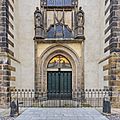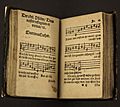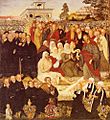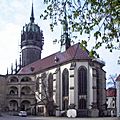Martin Luther facts for kids
Quick facts for kids Martin Luther |
|
|---|---|
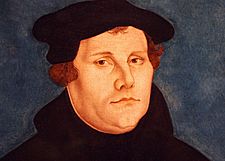
Martin Luther, painted by Lucas Cranach the Elder
|
|
| Religion | Christian |
| Church | Lutheran |
| Date of birth | November 10, 1483 |
| Place of birth | Eisleben |
| Date of death | February 18, 1546 (aged 62) |
| Place of death | Eisleben |
| Nationality | German |
| Known for | Starting the Protestant Reformation |
| Written works | The 95 Theses |
Martin Luther (10 November 1483 – 18 February 1546) was a German priest, professor, and important figure in Christian history. He is best known for starting the Protestant Reformation, a major movement that led to the creation of many different Christian churches separate from the Roman Catholic Church.
Contents
Early life
Martin Luther was born on November 10, 1483, in Eisleben, in what is now Germany. His father worked in copper mining. Martin was baptized the day after he was born, on the feast day of Saint Martin of Tours. His family later moved to Mansfeld.
His father wanted him to become a lawyer, so Martin went to schools that taught subjects like grammar, public speaking, and logic. He then went to the University of Erfurt, where he earned a master's degree in 1505.
However, instead of becoming a lawyer, Luther decided to become a monk. He joined the Augustinian monastery in Erfurt in 1505. He dedicated himself to prayer and study.
Becoming a Professor
Luther's superiors encouraged him to continue his studies, and he began teaching theology at the University of Wittenberg in 1508. Theology is the study of religion, especially Christianity. He earned his Doctor of Theology degree in 1512 and became a professor there for the rest of his career.
Luther's Ideas and the Ninety-five Theses
As Luther studied the Bible, he began to see some things differently from the teachings and practices of the Roman Catholic Church at the time. A key idea for Luther was "justification by faith alone." This means he believed that being made right with God is a free gift from God's kindness, received only through faith in Jesus Christ, not by doing good works or earning merit. He believed good works were important, but they were a result of faith, not a way to earn salvation.
One practice Luther strongly disagreed with was the selling of "indulgences." Indulgences were papers that people could buy, which were said to reduce the punishment for sins, either for themselves or for people who had died. In 1516, a friar named Johann Tetzel was selling indulgences in Germany to raise money to rebuild St. Peter's Basilica in Rome.
On October 31, 1517, Luther wrote a letter to his bishop protesting the sale of indulgences. He included a list of 95 points for discussion, known as the "Ninety-five Theses." These theses questioned the power of the Pope to grant indulgences and the idea that buying them could forgive sins or release souls from a place called purgatory.
According to one famous story, Luther nailed his Ninety-five Theses to the door of the All Saints' Church in Wittenberg on that day. While some historians debate if this specific event happened exactly that way, the theses were definitely written and quickly spread throughout Germany and beyond, thanks to the printing press.
Conflict with the Church
Luther's ideas caused a big stir. The Roman Catholic Church saw his views as challenging their authority and teachings. Pope Leo X demanded that Luther take back his writings. When Luther refused, the Pope officially removed him from the Church (this is called excommunication) in January 1521.
Later that year, the Holy Roman Emperor Charles V called a meeting called the Diet of Worms. Luther was asked to appear and explain his views. He was asked if he would take back his writings. Luther famously refused unless he could be convinced by the Bible or clear reason, saying his conscience was tied to the Word of God. Because he refused, the Emperor declared him an outlaw, meaning anyone could capture or even kill him without punishment, and it was illegal to help him.
Hiding and Translating the Bible
To protect him, Prince Frederick III of Saxony arranged for Luther to be safely hidden at Wartburg Castle. While he was there, Luther worked on translating the New Testament from Greek into German. This was a very important project because, before this, the Bible was mainly available in Latin, which most ordinary people could not read. Luther's translation made the Bible accessible to many more people in Germany, allowing them to read and interpret it for themselves. He and others later translated the Old Testament as well, completing the entire Bible in German by 1534.
Luther's translation also had a big impact on the German language itself, helping to create a more standard way of writing and speaking German.
Return to Wittenberg and Challenges
Luther returned to Wittenberg in 1522. He worked to guide the changes happening in the church there, which were inspired by his ideas. He preached sermons encouraging people to rely on God's word rather than violence to bring about change.
During this time, there were also peasant uprisings in Germany. The peasants had many complaints about their living conditions and the ruling classes. Some people thought Luther's challenge to the church's authority meant he would support their revolt against the nobles. However, Luther did not support the violent rebellion and urged the peasants to obey the authorities, although he did sympathize with some of their grievances.
Marriage and Family
In 1525, Martin Luther married Katharina von Bora, who had been a nun. At the time, priests and nuns were not allowed to marry in the Roman Catholic Church. Luther's marriage was a significant event that set an example for Protestant clergy to marry and have families. Martin and Katharina had a happy marriage and had six children together. Katharina helped manage their household, which included taking in students as boarders to help make money.
Organizing the New Church
As the Protestant movement grew, Luther became involved in organizing the new churches. He helped establish a structure for the church and developed new forms of worship services. He also wrote catechisms, which are simple books of instruction on the basics of Christian faith, like the Ten Commandments, the Lord's Prayer, and the Apostles' Creed. His Small Catechism was designed to help parents teach their children. These catechisms are still used today in Lutheran churches.
Hymns and Music
Luther loved music and believed it was important in worship. He wrote many hymns, including famous ones like "A Mighty Fortress Is Our God." He wanted the congregation to participate in singing during services, and his hymns helped spread the ideas of the Reformation through music.
Later Life and death
In his later years, Luther continued to write and teach. He also expressed strong negative views about certain groups, including Jewish people. These writings are a sad and difficult part of his legacy. Historians have different opinions on how much these views influenced later events, but they are widely condemned today.
Luther suffered from various health problems in his later life. He died on February 18, 1546, at the age of 62, in Eisleben, the town where he was born. He was buried in the church in Wittenberg where he had posted his Ninety-five Theses.
Legacy
Martin Luther's actions and ideas had a massive impact on Christianity and European history. The movement he started, the Protestant Reformation, led to the formation of many different Christian denominations, including Lutherans, Calvinists, and others. His translation of the Bible made it more accessible, and his emphasis on faith and the authority of the Bible over church traditions changed the course of religious history. He is remembered as a courageous figure who stood up for his beliefs, even when it meant facing powerful opposition.
Related pages
See also
 In Spanish: Martín Lutero para niños
In Spanish: Martín Lutero para niños
Images for kids
-
Portraits of Hans and Margarethe Luther by Lucas Cranach the Elder, 1527
-
Former monks' dormitory, St Augustine's Monastery, Erfurt
-
A posthumous portrait of Luther as an Augustinian friar
-
Luther's theses are engraved into the door of All Saints' Church, Wittenberg. The Latin inscription above informs the reader that the original door was destroyed by a fire, and that in 1857, King Frederick William IV of Prussia ordered a replacement be made.
-
The Catholic sale of indulgences shown in A Question to a Mintmaker, woodcut by Jörg Breu the Elder of Augsburg, c. 1530
-
Pope Leo X's Bull against the errors of Martin Luther, 1521, commonly known as Exsurge Domine
-
The meeting of Martin Luther (right) and Cardinal Cajetan (left, holding the book)
-
The Wartburg room where Luther translated the New Testament into German. An original first edition is kept in the case on the desk.
-
Katharina von Bora, Luther's wife, by Lucas Cranach the Elder, 1526
-
Luther on the left with Lazarus being raised by Jesus from the dead, painting by Lucas Cranach the Elder, 1558
-
Luther on his deathbed, painting by Lucas Cranach the Elder
-
Luther Monument in Eisenach, Germany







